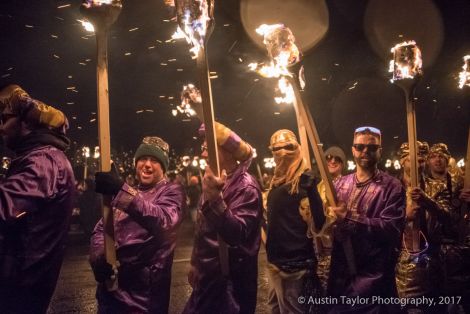Viewpoint / Spirals of fire, conviviality & the vexed matter of shield-maidens: how an outsider sees UHA
IN A feature article, first written for iScot magazine and reproduced here, journalist Zoe Weir offers an outsider’s perspective on the Lerwick Up Helly Aa.
Shetlanders do not like being put in a box. Not by cartologists, who tend to squeeze the Northern Isles into a peerie square just off Scotland. Not by historians, who still debate whether Vikings wiped out Shetland’s Pictish natives or assimilated with them. Not by political pundits, for Shetland is a law unto itself; and never more so than during their annual fire festival, Up Helly Aa. This unique spectacle claims Viking connections, but in truth was forged in Victorian times; to this day it retains a “no-women” rule hotly debated by islanders.
Scotland’s rich Viking legacy is nowhere more visible than in the Northern Isles, which were under Norse rule between the ninth and 15th centuries. Twenty nine per cent of Shetland’s men have some Viking DNA; the Old Norn language, descended from the Norse tongue, still dominates the place names, surnames and local dialect. Remnants of Viking structures are dotted around the island; experts believe more sit unmarked beneath the peaty soil.
Yet Up Helly Aa’s story begins much later, after the Napoleonic wars (1803-1815). Young soldiers, returning from gunpowder-charged battles, craved adrenaline-fuelled release, and Yule celebrations grew ever more riotous. By 1840, the holiday “extreme sport” of choice involved young men careering up and down narrow streets dragging barrels of blazing tar on home-made bogies. Teams raced against each other, a barrel apiece, leaving a trail of collateral damage that left property smoking and villagers fuming. Tolerant townsfolk would then open their homes to the young men who, after a quick scrub down, would turn up in squads, dressed in homemade disguises, to eat, drink and be merry. Each squad would perform a skit of low farce or political satire, and paired dancing with local lassies would follow. Shetland’s “guizing” dates back to medieval “skeklers”; crofters dressed in costumes of straw.
Become a member of Shetland News
“Tar-barrelling” was banned by the Town Council in 1874; the undampened youngsters sought permission to hold a torchlit procession. They succeeded in 1876, and the next few years saw a committee form and trial various ideas, some lasting until today. One of these is the festival’s name, which probably came from “Uphellya”, 16th century Lowland Scots for “Twelfth Night”, precursed by Old Norse “helli uppi” (“holy-day at an end”). Another was the addition in the late 1880s of a truly un-Scandi brass band and equally non-Norse pipers to the procession. It was not until 1889 that a lone Viking enthusiast, J.J.Haldane Burgess, is believed to have added the galley, transforming the festival’s meaning. In 1896, a procession song, The Norseman’s Home, was essayed, and has stayed in use. Tellingly, the final stanza has been dropped:
“Then may Victoria rule the land,
Our laws and rights defend,
One cheer then give with heart and hand –
The Queen! – the people’s friend.”
A guizer “Jarl” first led the procession in 1906, and had his own squad from 1920. It is now they who commence festivities by posting the Bill at the Market Cross at 6.30am. This satirical “Proclamation” contains coded Shetland in-jokes and political commentary; this year there was a dig at nearby Scalloway’s UHA, for daring to replace their galley’s dragon head with that of a great white shark. Hirsuted and booted, the Vikings roar and sweat their way through multiple public appearances over the next two days and nights. A young squad wife confided that the massive weight of the outfit is too much for the older men, who have swapped non-visible metal links in their chain-mail for rubber ones.
The main attraction for visitors is the torchlit procession, where the sixty-strong Jarl Squad lead 800-900 guizers in a variety of outlandish, homemade fancy-dress to the climactic burning of a wooden galley. This full-length Viking longship is made of far-Eastern ply, as trees are scarce on Shetland (due to strong winds, not excessive fiddle-making as locals claim). The hand-painted ship is made, like the torches, by all-male volunteers, and is ferried around town on a 1938 bus chassis, with a Ford Transit gearbox for steering. Eight years ago a brake was added to meet insurance requirements. An endless double line of flame snakes through the darkened streets, eventually coiling in ever-tighter spirals around its sacrificial offering. The Jarl gives a testosterone-fuelled yell, then a secret command to his squad. “Grip his pilly!” he shouts, and the conquering hordes hurl their torches into the doomed longship.
Nine Up Helly Aas occur elsewhere on Shetland between December and March; some feature a seaworthy galley which is floated offshore on its infernal ascent to Valhalla. This is closer to an authentic Jarl funeral service than Lerwick’s landlocked playpark burning. Yet the sight of this magnificent vessel, ablaze and surrounded by a thousand howling Berserkers, is unforgettable. The toppling of the main mast kicks off private all-night revelry celebrating the imminent lengthening of daylight hours. The “country” UHAs allow women to take part, and in 2015 the first female Guizer Jarl headed the South Mainland Up Helly Aa. Such goings-on cause shudders in Lerwick, where gender roles diverge sharply at secondary-school age.
A Lerwegian’s journey to Guizer Jarl begins at twelve years of age when he serves as a “fiddlebox-carrier”, lugging the instruments and props off and onto the vans as his squad visits each of twelve Halls. He attempts (in vain) to keep the inebriated guizers to schedule, and to survive a right-of-passage all-nighter of booze, dancing, and homespun entertainment. Years of torch-making and galley-building follow; in his twenties, he finds a place on one of 47 squads and rehearses a group skit to entertain ladies waiting at the Halls. Eventually he may apply for a place on the 17-strong committee. The winner each year (voted for by other guizers) replaces the longest-standing member; in his sixteenth committee year, he will be Jarl. The following year he is UHA’s Marshal, before passing on his galley-shed keys to that year’s new member. The men who ascend to Jarlhood, then, are those least likely to have made the transition from Norseman to “Vikingr”, or “one who makes an expedition” – for the huge commitment allows for no time away from Shetland.
From September of each year, Lerwegian craftsmen prepare the Jarl’s Squad costumes. These yearn to be genuinely Viking, but are far more ornate and costly, at around £1,500 each. One future Jarl spoke of his annoyance at the preponderance of “fake history” horned helmets, stemming from costume design in 19th century Wagnerian opera. False beards and wigs were the norm in the 1950s, when “respectable” workers had to be clean-shaven. These days the Jarl squad race to reach “peak beard”. It takes 15 months to cultivate the full “beardaclava”, although real Viking males were clean and neatly-combed, with trimmed, styled facial hair and sometimes make-up.
The tradition of women helpers admiring Viking exploits has precedent in both mythical Icelandic saga and in Skaldic verse. The Valkyries, hand-maidens of Odin, are depicted in Viking art offering drinking horns to welcome dead heroes. Yet this diminished female role is in direct contradiction to pre-Victorian custom on Shetland. Prior to the arrival of prudish Presbyterianism from “doon sooth” (yes, they mean Scotland!) in around 1840, women enjoyed “different-but-equal” status, working the crofts alone while their menfolk fished at sea. They held prominent public places in Lerwick, were prepared to find recourse in the law when wronged, and were not stigmatised for having sex outside of marriage. Would they have been content to serve endless bannocks and Shetland Reestit mutton soup in the Halls? Perhaps the older hall hostesses, fiercely opposed to female guizers, fear a decline in Shetland’s birth rate, for they say there is a spike in births around nine and a half months after the festival…
This mating ritual of scantily-clad Lerwick lassies lining up to dance an eightsome reel with their strutting heroes is one way of surviving the long winter. But in a 2015 poll by The Shetland Times, 68 per cent of islanders voted to let girls into guizing. Stalwarts within UHA power circles parrot the script that its traditions will never change; yet the only unchanging element of UHA is that it has always changed.
Academics disagree on whether shield-maidens were a Norse norm, but there is evidence to suggest they were not unheard of. The 12th century Danish historian Saxo Grammaticus described Danish women who “dressed themselves to look like men…spent every minute cultivating soldiers’ skills…(and) courted military celebrity”. What is sure is that almost half of those arriving in Shetland on Norse ships were female.
Jokingly, some argue women are “already represented” by the regular appearance of crossed-dressed male guizers, provoking islanders to nickname Lerwick’s UHA “transvestite Tuesday”. Incidentally, there is precedent in Poetic Edda; Thor disguises himself as the lovely goddess Freyja in order to steal back his hammer from the giant Thrym, much to the amusement of the mischievous Loki. It is true that squads have waiting lists, but places are often fluid and used intermittently. Any man serious enough can find a place within a few years, even if they are a newcomer to the island. Will the committee consider capping squad size to make space for the fair sex? The girls in primary six at the local school hope so – nearly all said they wanted the chance to be a Viking. Alas, lists of Guizer Jarls over the decades read like a family tree, suggesting UHA “fairness” is a relative thing. As one young guizer confides, “It’s all a bit mafia”.
Yet in one final Shetland contradiction, there’s no Wicker Man here; convivial with strangers and bonded to each other, it’s impossible not to love Lerwegians. As the Jarl’s Squad raise their voices not in war cries, but in love songs to the adoring crowd, men and women alike are moved to tears. Lerwick’s UHA is unbeatable in terms of scale; but the “country” Up Helly Aas may give more insight into the island’s easy-going, humorous innovation. Which is why we may soon see a triumphant shield-maiden putting the “she” back into Shetland.
Zoe Weir
This article originally appeared in the March edition of iScot magazine, which you can access digitally here: http://www.pocketmags.com/iscot
Become a member of Shetland News
Shetland News is asking its many readers to consider paying for membership to get additional features and services: -
- Remove non-local ads;
- Bookmark posts to read later;
- Exclusive curated weekly newsletter;
- Hide membership messages;
- Comments open for discussion.
If you appreciate what we do and feel strongly about impartial local journalism, then please become a member of Shetland News by either making a single payment, or setting up a monthly, quarterly or yearly subscription.



























































